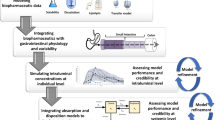Abstract
Background and Objective
The US Food and Drug Administration (FDA) has seen a recent increase in the application of physiologically based pharmacokinetic (PBPK) modeling towards assessing the potential of drug–drug interactions (DDI) in clinically relevant scenarios. To continue our assessment of such approaches, we evaluated the predictive performance of PBPK modeling in predicting cytochrome P450 (CYP)-mediated DDI.
Methods
This evaluation was based on 15 substrate PBPK models submitted by nine sponsors between 2009 and 2013. For these 15 models, a total of 26 DDI studies (cases) with various CYP inhibitors were available. Sponsors developed the PBPK models, reportedly without considering clinical DDI data. Inhibitor models were either developed by sponsors or provided by PBPK software developers and applied with minimal or no modification. The metric for assessing predictive performance of the sponsors’ PBPK approach was the R predicted/observed value (R predicted/observed = [predicted mean exposure ratio]/[observed mean exposure ratio], with the exposure ratio defined as [C max (maximum plasma concentration) or AUC (area under the plasma concentration–time curve) in the presence of CYP inhibition]/[C max or AUC in the absence of CYP inhibition]).
Results
In 81 % (21/26) and 77 % (20/26) of cases, respectively, the R predicted/observed values for AUC and C max ratios were within a pre-defined threshold of 1.25-fold of the observed data. For all cases, the R predicted/observed values for AUC and C max were within a 2-fold range.
Conclusion
These results suggest that, based on the submissions to the FDA to date, there is a high degree of concordance between PBPK-predicted and observed effects of CYP inhibition, especially CYP3A-based, on the exposure of drug substrates.



Similar content being viewed by others
References
Rostami-Hodjegan A. Physiologically based pharmacokinetics joined with in vitro-in vivo extrapolation of ADME: a marriage under the arch of systems pharmacology. Clin Pharmacol Ther. 2012;92:50–61.
Rowland M, Peck C, Tucker G. Physiologically-based pharmacokinetics in drug development and regulatory science. Annu Rev Pharmacol Toxicol. 2014;51:45–73.
Huang SM, Abernethy DR, Wang Y, Zhao P, Zineh I. The utility of modeling and simulation in drug development and regulatory review. J Pharm Sci. 2013;102:2912–23.
Zhao P, Zhang L, Grillo JA, Liu Q, Bullock JM, Moon YJ, Song P, Brar SS, Madabushi R, Wu TC, Booth BP, Rahman NA, Reynolds KS, Gil Berglund E, Lesko LJ, Huang SM. Applications of physiologically based pharmacokinetic (PBPK) modeling and simulation during regulatory review. Clin Pharmacol Ther. 2011;89:259–67.
Zhao P, Rowland M, Huang SM. Best practice in the use of physiologically based pharmacokinetic modeling and simulation to address clinical pharmacology regulatory questions. Clin Pharmacol Ther. 2012;92:17–20.
Sinha V, Zhao P, Huang SM, Zineh I. Physiologically based pharmacokinetic modeling: from regulatory science to regulatory policy. Clin Pharmacol Ther. 2014;95:478–80.
Vieira MD, Kim MJ, Apparaju S, Sinha V, Zineh I, Huang SM, Zhao P. PBPK model describes the effects of comedication and genetic polymorphism on systemic exposure of drugs that undergo multiple clearance pathways. Clin Pharmacol Ther. 2014;95:550–7.
Guest EJ, Aarons L, Houston JB, Rostami-Hodjegan A, Galetin A. Critique of the two-fold measure of prediction success for ratios: application for assessment of drug–drug interactions. Drug Metab Dispos. 2011;39:170–3.
Jamei M, Dickinson GL, Rostami-Hodjegan A. A framework for assessing inter-individual variability in pharmacokinetics using virtual human populations and integrating general knowledge of physical chemistry, biology, anatomy, physiology and genetics: a tale of ‘bottom-up’ vs ‘top-down’ recognition of covariates. Drug Metab Pharmacokinet. 2009;24:53–75.
Application of PBPK modeling to support dose selection: public meeting March 10, 2014. http://www.regulations.gov/#!docketDetail;D=FDA-2014-N-0129. Accessed 29 Aug 2014.
Peters SA, Schroeder PE, Giri N, Dolgos H. Evaluation of the use of static and dynamic models to predict drug–drug interaction and its associated variability: impact on drug discovery and early development. Drug Metab Dispos. 2012;40:1495–507.
FDA advises against using oral ketoconazole in drug interaction studies due to serious potential side effects. 2013. http://www.fda.gov/drugs/drugsafety/ucm371017.htm. Accessed 17 July 2014.
Ke AB, Zamek-Gliszcznski MJ, Higgins JW, Hall SD. Itraconazole and clarithromycin as ketoconazole alternatives for clinical CYP3A inhibition studies. Clin Pharmacol Ther. 2014;95:473–6.
Acknowledgments
The authors sincerely acknowledge Drs. Shiew Mei Huang and Issam Zineh (Office of Clinical Pharmacology, FDA) for their valuable comments and advice during the preparation of this manuscript.
This project was supported in part by an appointment to the ORISE Research Participation Program at the Center for Drug Evaluation and Research (CDER) administered by the Oak Ridge Institute for Science and Education through an agreement between the US Department of Energy and CDER.
This project was supported in part by the Commissioner Fellowship Program from the FDA Office of Commissioner, Office of Chief Scientist, and Office of Scientific Professional Development.
All authors have no conflicts of interest that are directly relevant to the content of this manuscript.
Disclaimer
The contents of this manuscript do not reflect the view or policies of the FDA or its staff. No official support or endorsement by the FDA is intended or should be inferred.
Sponsors used commercially available software platforms (GastroPlus™, PK-Sim®, and Simcyp®). The FDA does not recommend any specific software for PBPK predictions and expects the sponsors to be solely responsible for selecting appropriate PBPK modeling tools to address drug development questions.
Author information
Authors and Affiliations
Corresponding author
Additional information
C. Wagner and Y. Pan: First authorship with equal contribution.
Rights and permissions
About this article
Cite this article
Wagner, C., Pan, Y., Hsu, V. et al. Predicting the Effect of Cytochrome P450 Inhibitors on Substrate Drugs: Analysis of Physiologically Based Pharmacokinetic Modeling Submissions to the US Food and Drug Administration. Clin Pharmacokinet 54, 117–127 (2015). https://doi.org/10.1007/s40262-014-0188-4
Published:
Issue Date:
DOI: https://doi.org/10.1007/s40262-014-0188-4




